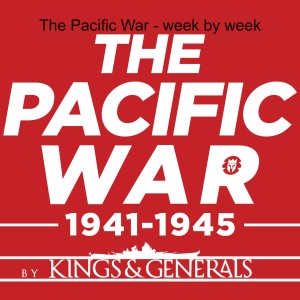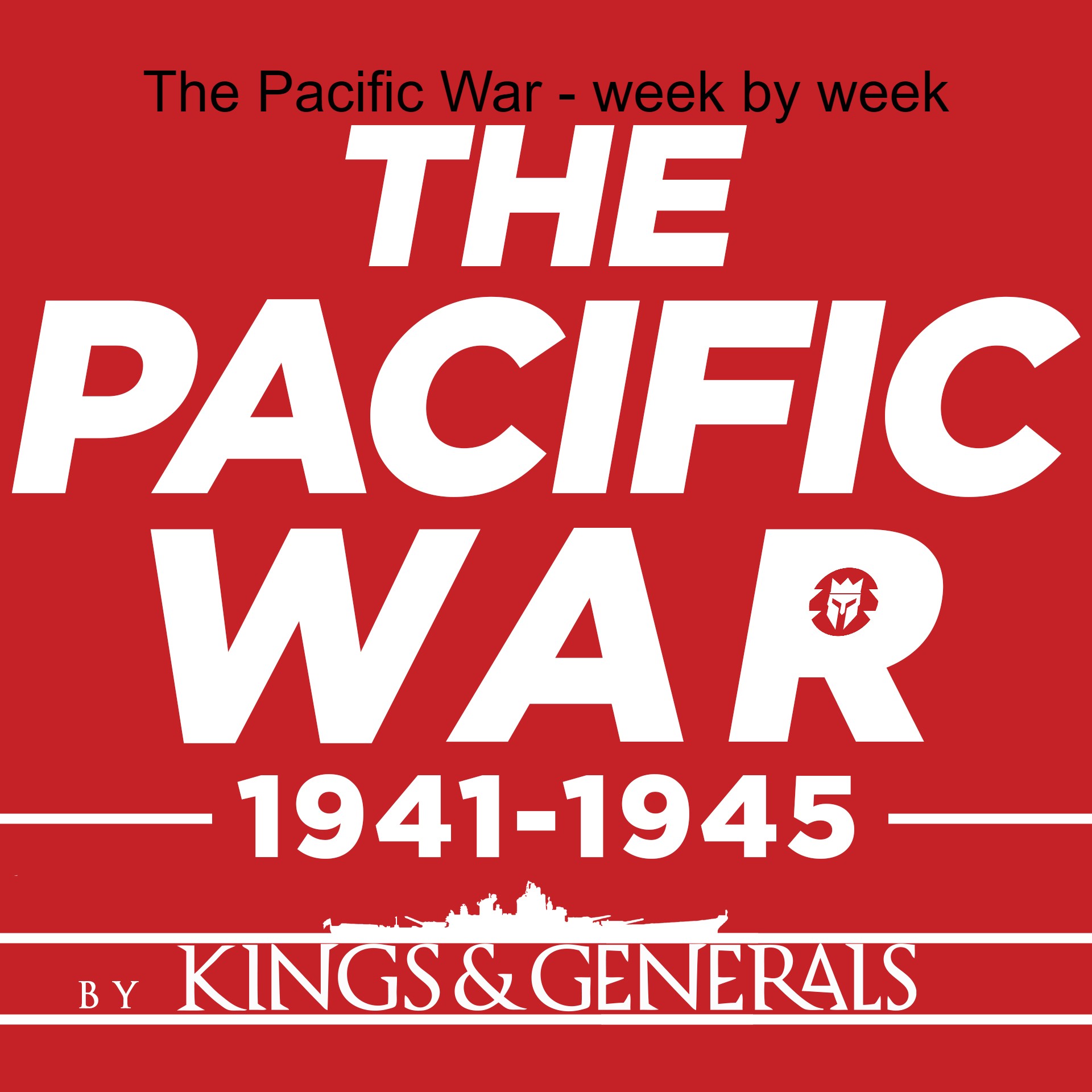Episodes

Tuesday Sep 06, 2022
- 42 - Pacific War - Milne bay counteroffensive, September 6-13, 1942
Tuesday Sep 06, 2022
Tuesday Sep 06, 2022
Back on August 24, the Japanese had commenced their amphibious invasion of Milne Bay, aiming to occupy the airstrip at Rabi to employ it for the overland drive against Port Moresby. Believing it to be held by few enemy soldiers, Admiral Mikawa only sent forward a small force of SNLF marines, which would be vastly outnumbered by the Milne Force of General Clowes; but despite their numerical inferiority and the constant threat of enemy air attacks, the Japanese expertly employed their two Ha-Go tanks to support their brave assaults against the Australian positions, reaching the Rabi airstrip by August 28. Now, however, the strength of the defenders was beginning to show; and they would soon prepare for an all-out counterattack, one that would drastically change the course of the battle. Join us as we cover the conclusion of the Battle of Milne Bay, as well as some new developments in Guadalcanal and the Kokoda Track, as the Japanese continue to press for their objectives.

Tuesday Aug 30, 2022
Tuesday Aug 30, 2022
In our last episode, we covered the carrier Battle of the Eastern Solomons, as the Japanese attempted to land reinforcements on Guadalcanal, and we’ve also covered the start of the Battle of Milne Bay, in which a numerically-inferior Japanese force managed to push back the defenders towards the airfield at Rabi. Yet during this period, new developments were also unfolding in the Kokoda Track. With the bulk of the South Seas Detachment finally on New Guinean soil, the Japanese now prepared to start their main drive against Port Moresby; an offensive that would be opposed by brave Australian soldiers in what is considered as Australia’s Thermopylae. Join us as we cover the Battle of Isurava and the Japanese Advance on Eora Creek.

Thursday Aug 25, 2022
- 40 - Pacific War - Battle of the East Solomons, August 23-30, 1942
Thursday Aug 25, 2022
Thursday Aug 25, 2022
During the last year, the Japanese Army proved to its adversaries that it was an unstoppable behemoth, defeating the British, American, Dutch, Indian and Australian forces at every place they managed to advance on. But in the last week, their so-called invincibility was finally debunked with the defeat of the Ichiki Detachment at Alligator Creek; yet the conclusion of the Battle of the Tenaru also harboured the start of a new phase for the Guadalcanal Campaign, a period in which the Marines and the US Navy were going to be challenged by some of the best forces of the Japanese Empire. Join us as we cover the Battle of the Eastern Solomons, as well as new developments in the New Guinea Campaign with the start of the Invasion of Milne Bay

Tuesday Aug 16, 2022
- 39 - Pacific War - Battle of Alligator Creek, August 16-23, 1942
Tuesday Aug 16, 2022
Tuesday Aug 16, 2022
Guadalcanal was one of the most brutal campaigns of the Pacific War, as the US Marines not only had to fight the relentless assaults of the enemy in that jungle hell, they also had to fight malnutrition, lack of supplies and tropical diseases that would eventually disable nearly two-thirds of General Vandegrift’s force. Yet after the Battle of Savo Island, these problems were only starting to emerge for the Marines, as they were soon to face a true baptism of fire at Alligator Creek. At the same time, the 2nd Raider Battalion was preparing to launch a deadly raid against the heart of the Gilberts, an attack that would have deadly consequences for the Americans in the future. Join us as we cover the Raid on Makin Island and we also take a look at the Battle of the Tenaru and some other developments in the Guadalcanal Campaign.

Tuesday Aug 09, 2022
- 38 - Pacific War - Battle of Savo Island, August 9-16, 1942
Tuesday Aug 09, 2022
Tuesday Aug 09, 2022
The disastrous Battle of Midway is remembered nowadays as one of the major turning points of the Pacific War, leaving the IJN significantly weakened. The Japanese would still continue to secure more territory, but it was now the allies who held the strategic initiative, and the Americans would then go on to execute Operation Watchtower, the first Allied offensive of the Pacific War; and as we’ve seen last week, the invasion of the Solomons was up to a good start. Yet despite its tremendous losses at Midway, the IJN was still standing and it still had sufficient strength to contest control of the south seas from the US, so Admiral Mikawa now prepared for a bold naval ambush that would prove to be one of the worst defeats in the history of the US Navy. Join us as we cover the Battle of Savo Island, and as we also take a look at some new developments on the Kokoda Track

Tuesday Aug 02, 2022
- 37 - Pacific War - Invasion of Solomon Islands, August 2-9, 1942
Tuesday Aug 02, 2022
Tuesday Aug 02, 2022
After eight months since the outbreak of the Pacific War, after many defeats at the hands of the invaders, and after many bold actions that resulted in the few successes that the Allies enjoyed during the war, the time is finally ripe for the start of the first Allied offensive against the Japanese Empire: the Invasion of the Solomon Islands. Yet this was not only the first Allied offensive of the Pacific War, this was also the first American amphibious invasion in many decades, an invasion that would cement the importance of the US Marines for years to come. Welcome to our episode on the start of the crucial Solomon Islands Campaign, covering the initial landings on Guadalcanal, Tulagi and the islands of Gavutu and Tanambogo.

Tuesday Jul 26, 2022
- 36 - Pacific War - The battle of Kokoda, July 19-August 2, 1942
Tuesday Jul 26, 2022
Tuesday Jul 26, 2022
In the last couple of weeks, we have covered both the American and Japanese general plans for the future, delving into the minds of important figures like General MacArthur, Admiral King, General Hyakutake or Admiral Yamamoto. Although the American plans haven’t quite gotten in motion yet, the Japanese had started their Kokoda Track campaign in the last episode; and today, we are going to cover the continuation of the Japanese advance on Kokoda, as well as the resistance offered by the Maroubra Force and the plans that were brewing in Burma for future operations in the region.

Tuesday Jul 19, 2022
- 35 - Pacific War - The invasion of Buna-Gona, July 19-26, 1942
Tuesday Jul 19, 2022
Tuesday Jul 19, 2022
Three weeks ago, we delved for the first time into the American plans for their future offensives, as the Army and Navy factions clashed for control of the operations that were going to unfold in the Pacific. But thanks to the efforts of General Marshall, by early July, the matter of command had been resolved and a compromise between General MacArthur and Admiral King had been reached. Now, we turn to cover the plans of the Japanese commanders for the region of New Guinea, as well as MacArthur’s response and the aid that the British were planning to give to the Americans in the Pacific.

Tuesday Jul 12, 2022
- 34 - Pacific War - The War on the North American Coast, July 12-19, 1942
Tuesday Jul 12, 2022
Tuesday Jul 12, 2022
The Aleutian islands were not the only territories in North America to be attacked by Japan. About a week after the attack on Pearl Harbor, 9 submarines of the Japanese 6th Fleet arrived off the North American Pacific coast. They were tasked with performing reconnaissance and disrupting shipping lanes. Some of these submarines would go a step further and carry out attacks on the mainland of North America. This episode will be the War on the American Pacific Coast.

Tuesday Jul 05, 2022
- 33 - Pacific War - Biological Warfare in China, July 5-12, 1942
Tuesday Jul 05, 2022
Tuesday Jul 05, 2022
Last month, we covered the start of the violent and unforgiving campaign that took place in the provinces of Zhejiang and Jiangxi as the Japanese invaders hunted down the American pilots that had taken part in the Doolittle Raid. In their ensuing struggle to curb down the Chinese air power in the region, the natives of Zhejiang and Jiangxi suffered the abuse and savagery of the Japanese troops, who caused such devastation on the land that around 90% of the market towns and its homes were destroyed. In many cities, the streets were left void and one could only see ruins and burning houses on the horizon. Yet this was just the beginning, with the invaders now preparing to withdraw from the area with the employment of biological warfare, thus leaving only death and misery in their wake.

